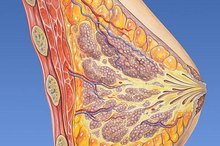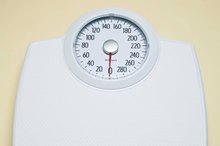Why Does Your Waistline Increase at Menopause?
Dealing with menopause and the changes it brings can be a challenge. Hot flashes, mood swings, loss of sexual desire and depression are all symptoms that can occur, along with weight gain around the waist and abdomen. Your hormones fluctuate during this stage of life, affecting your metabolic rate, fat distribution and stress levels. All these factors can alter the shape of your body and the size of your waist.
Complications
A small amount of weight gain can be healthy and in fact prevent osteoporosis, a condition involving the deterioration of your bone density, resulting from reduced estrogen levels. However, excessive weight gain around your midsection may be a cause for concern, depending on the location of the fat. Subcutaneous fat is the kind that is easy to grab, forming between the outer skin and abdominal wall. Visceral fat is deeply embedded and surrounds your abdominal organs. A 2006 article on the Harvard Health Publications website suggested visceral fat releases cytokines, which are chemicals that increase the risk of cardiovascular disease and type 2 diabetes. Visceral fat can also lead to breast cancer and high blood pressure.
Estrogen
What Hormones Are Responsible for Libido?
Learn More
Estrogen is a hormone central to the reproductive process in women. It regulates the menstrual cycle and helps thicken the uterine wall to prepare for conception and pregnancy. Ovaries produce less estrogen during menopause. As a consequence, the body begins to transform the majority of your caloric intake into fat, instead of muscle. This is your body's way of obtaining estrogen, also produced by fat cells. You are more likely to put on weight during menopause, as fat cells burn fewer calories than muscle cells.
Testosterone
Although men have greater quantities of the hormone testosterone, it is also found in women. Testosterone helps your body produce lean muscle mass from your caloric intake to increase your metabolic rate. During menopause, testosterone levels drop and the female metabolism slows down. As a result, your body burns fewer calories.
Androgen
Why Do Women Need Estrogen?
Learn More
Androgen, known as the male hormone, occurs in women in small quantities. Androgen stimulates sexual libido, raises energy levels and enhances your mood. Elevated levels in females cause facial hair, a deepened voice and fat cells to form around the midsection. Although androgen levels decrease during menopause, estrogen levels drop at a higher rate, making androgen higher in ratio. Prior to menopause, you may carry more weight in the hip and thigh area. Overweight men tend to accumulate weight around the stomach and waist area, and during menopause, you may also notice a shift in the way fat is deposited. Adipose fat collects around your midriff area and decreases in your legs and arms.
Progesterone
A larger waistline is not always due to extra fat. Water retention can contribute to a bulging midsection. Progesterone, a hormone vital for fertility and various stages of pregnancy, decreases during menopause. According to a 2010 article on the Body Logic MD website, a decrease in progesterone results in water retention, causing your stomach to bloat, increasing the size of your waistline.
Stress
During menopause, you may experience higher levels of stress, anxiety and depression. Chronic stress triggers the release of the stress hormone cortisol. According to a 2001 article by Dr. Marilyn Glenville, elevated levels of cortisol can contribute to weight gain around the waist. Cortisol is designed to give you a five- to 10-minute burst of energy during times of danger to support the fight or flight mode. As chronic stress has become a common factor in modern-day life, the body is unable to distinguish a serious threat from an everyday situation, and the release of energy often goes unused, resulting in weight gain.
Related Articles
References
Writer Bio
Eshe Asale is a holistic massage therapist who began writing in 1995 with articles appearing on various websites and in "Iqra" newspaper and the "Between Love, Hope and Fear" anthology. She holds a massage therapy certificate from Lourdes Institute, a Master of Arts in media studies/communications from Goldsmiths University and a Bachelor of Arts in writing and publishing/film studies from Middlesex University.









